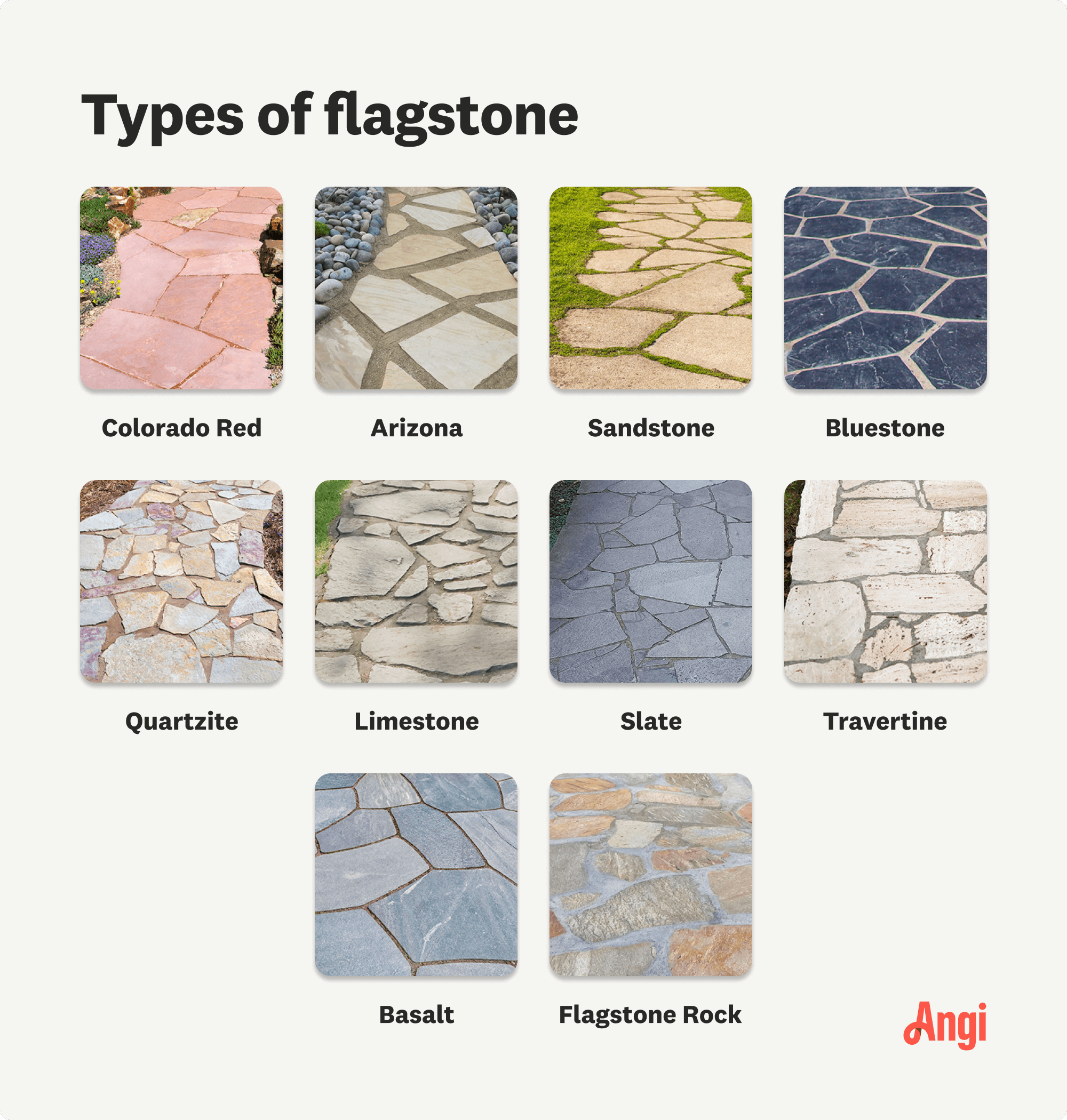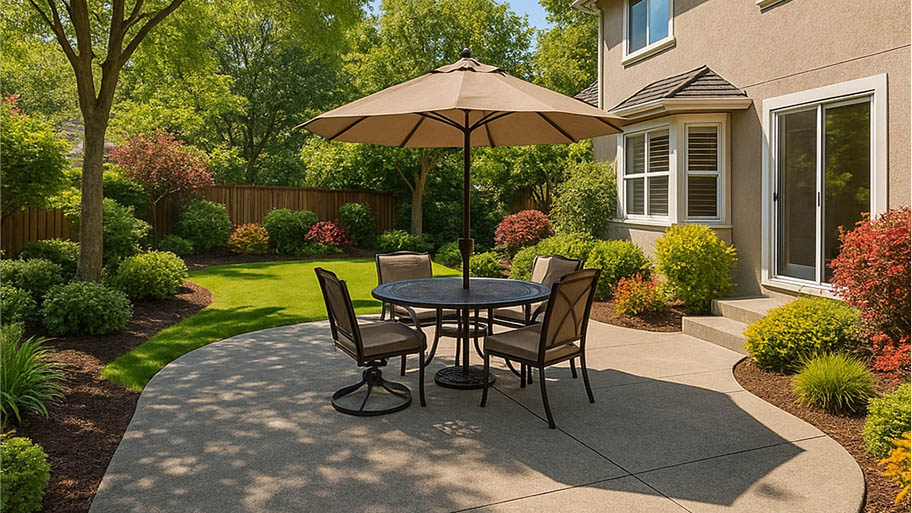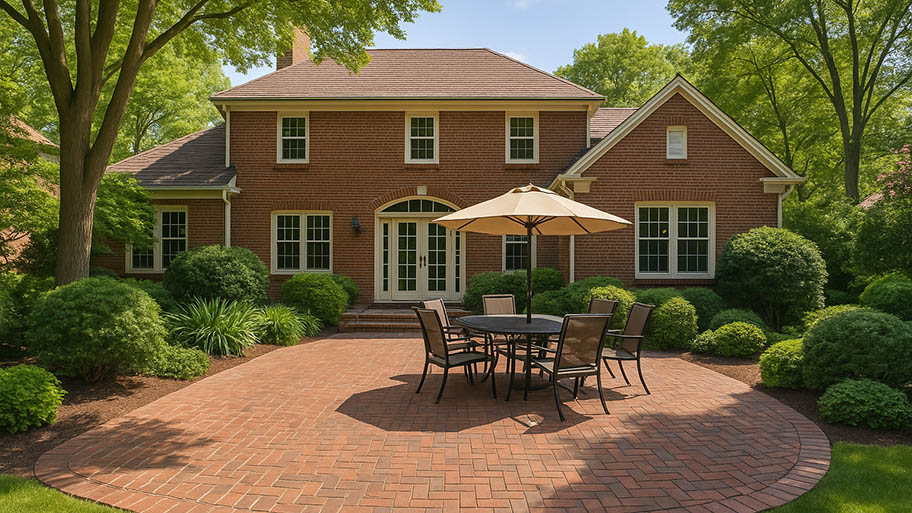
Thinking of adding a pergola to your backyard space? Find out motorized pergola costs by size, material, and add-on features with this guide.
Flagstone costs anywhere from $200 to $550 per ton


Flagstone costs anywhere from $200 to $550 per ton.
Different flagstone materials have a large impact on cost, with quartzite flagstone a common higher-end option that costs $400 to $450 per ton.
A ton of flagstone typically covers up to 140 square feet.
You’ll pay $2 to $6 per square foot for the stone itself, not including labor.
You can save money choosing a less expensive stone type or switching to pavers.
Flagstone is naturally beautiful, with colors ranging from sand or gray to red or purple. It has a rustic charm, mainly if rough cut, and is incredibly durable. It's more affordable than many other types of stone, ranging from $2 to $6 per square foot for the stone itself. However, some flagstone types cost between $10 and $15 per square foot. You'll also need to account for $13 to $16 per square foot for labor.
A few factors influence the cost of flagstone, including the unit of measurement and type of flagstone.
Flagstone pricing is usually given in one of three measurements:
Per ton
Per pallet
Per square foot
When talking to your local paving installers, clarify the size or unit of measurement so you know precisely how much paving you're getting for your money.
Flagstone costs between $200 and $550 per ton, just for the stone. For a mid-range type of flagstone, expect to pay around $350 per ton.
A ton of flagstone covers up to 140 square feet, but coverage depends on your flagstone’s type, fit (the space between stones), and thickness. A ton of thicker, denser flagstone could cover as little as 70 square feet. This is a critical pricing factor, so discuss coverage with your contractor.
Expect to pay anywhere from $600 to $2,200 for a whole pallet of flagstone. Pallet weights vary but usually fall between three and four tons, which equates to a cost of $0.20 to $0.55 per pound. An average pallet covers between 210 and 560 square feet, but, just as with flagstone coverage priced by the ton, how much square footage you get depends on thickness and density.
Flagstone costs per square foot range from $2 to $6 per square foot for the stone itself and between $15 and $22 per square foot with labor. Expect the price to fall at the higher end of this range for thicker stone and rarer flagstone colors.

Flagstone prices range from $200 to $550 per ton without labor. Prices depend on the type of stone, its quality, and rarity. Colorado red flagstone has the lowest cost, while travertine costs the most. Here’s how each flagstone type compares:
| Type | Cost per Ton | Description |
|---|---|---|
| Colorado Red Flagstone | $200–$400 | Popular choice for climates with extreme heat or cold |
| Arizona Flagstone | $200–$450 | Readily available, local to the Southwestern US |
| Sandstone | $200–$350 | Easy to find, more affordable than many other types |
| Bluestone | $375–$450 | Resistant to freezing temperatures, requires sealing in coastal locations |
| Quartzite | $400–$450 | Durable mix of sandstone and quartz well-suited to high-traffic areas |
| Limestone | $250–$400 | Commonly found, often left in its natural stone shape rather than squared off |
| Slate | $475–$700 | One of the priciest types, has a rich and textured appearance |
| Travertine | $800+ | Unique porous texture, rustic, and less common |
| Basalt | $500–700+ | Dark volcanic rock, highly resistant to stains and wear |
| Flagstone Rock | $400–$500 | Excellent choice for outdoor steps and natural walls |
Many variables impact the cost of flagstone, from the thickness of the stone to its rarity. Delivery, complexity, and accessibility also affect the price of any flagstone installation project.
Remember, flagstone costs $15 to $22 per square foot, meaning the cost of your flagstones will depend on the type of project. Here are the average costs to complete flagstone installations:
| Flagstone Project Type | Total Square Footage | Average Cost |
|---|---|---|
| Walkway | 300–500 sq. ft. | $4,500–$11,000 |
| Pathway | 125–250 sq. ft. | $1,900–$5,500 |
| Pool Deck | 600–900 sq. ft. | $9,000–$19,800 |
| Driveway | 300–600 sq. ft. | $4,500–$13,200 |
| Patio Installation | 50–400 sq. ft. | $750–$8,400 |
The flagstone's weight directly impacts cost, particularly if priced by the ton. Remember, flagstone comes in different thicknesses, with some pavers or flagstone rocks being 2 inches thick or more. Plus, different types of sandstone have different densities, so you get less square footage per ton for heavier stones.
The type of flagstone you choose influences how much you'll pay for the stone itself, and some types, such as those that need sealing, require extra labor. Standard flagstone, such as sandstone, is comparatively inexpensive, costing as little as $200 per ton, whereas scarcer types like bluestone or quartzite with unique patterns and colors can cost up to $550 per ton.
Flagstone is heavy, so the more you pay, the further it travels. Stone quarried locally doesn't have far to travel, so you'll get a better price (and have fewer problems with the stone's reaction to your climate). But if you simply must have the rare pink-purple quartzite flecked with gold that has to travel from the other side of the country, you'll quickly rack up extra fees in transport costs.
Your contractor will assess how accessible the job site is and figure that into their quote. Labor costs will increase if the contractors manually move the stone a long distance because they can't get the right vehicle or equipment into your yard to do the lifting.
Since flagstone is a natural stone, you will want to compensate for variability. For example, contractors often order 25% more stone than they anticipate needing for a project because the stone can vary so much in color, texture, and shape, even when it comes from the same quarry.
A flagstone project, especially a large project covering significant ground, benefits from hiring a brick paving pro near you.
As you pick out flagstones for your property, we recommend consulting local installers, too. Here’s how an expert can help:
Even if you arrange delivery, flagstones are very heavy to install. The pros will save your back the work, and can handle bigger additions.
As pieces of natural stone, flagstones can be more susceptible to splitting or cracking, especially when handled improperly. Experts will treat the pieces with the necessary care.
Properly leveling the flagstones along the same surface is very important, requiring professional experience to avoid mistakes.
For larger projects, professionals use tools like laser levels, compactors for substrate, and stone saws that DIYers don’t have access to.
If you decide to DIY your flagstone project, start with these important steps:
Check if you can rent equipment from your local hardware store, including a compact and a saw with a blade for cutting stone.
Flagstone projects can take a surprising amount of excavation. Expect to dig four to six inches deep before laying the substrate layer.
Set a plan for removing significant dirt before using your substrate materials and stone.
For your own safety, only move one flagstone at a time and make use of your wheelbarrow to avoid injury.
When leveling out your substrate and flagstones, make them a bit lower than the nearby lawn. This makes it far easier to maneuver a mower that might otherwise crash into the flagstones.
If you want to amplify your outdoor space, be sure to leave space for these popular flagstone add-ons while you budget:
Fire pit: $200–$3,000
Outdoor kitchen: $6,300–$26,900
Outdoor sound system: $250–$1,300
Patio roof: $14,000–$31,000
Railing/fencing: $10–$90 per linear foot
Solar shades: $200–$1,300
Flagstone is a heavy material that can quickly add up in material, shipping, and labor costs. Fortunately, there are several things you can do to lower the cost of flagstones for your project, including:
Choose a budget-friendly flagstone type, like Colorado red flagstone or Arizona flagstone, over more costly options, like slate, travertine, or basalt.
Reduce the total square footage to lower material and labor costs.
Select a thinner thickness level.
Choose a material with less density so that the cost by weight is lower.
Go for flagstone sourced locally to reduce shipping costs.
Make your site accessible for the delivery and installation.
Avoid any unnecessary add-ons and stick with the essentials.
Set your total budget to accommodate the flagstone type hourly labor rate—then compare with estimates from brick pros.
Review flagstone samples and consult your brick pro for recommendations.
When getting estimates, note any areas where you want flagstones cut to fit in a particular spot or aesthetic, such as flagstones fitting against walls or flower beds.
Once you have a work date arranged, check the area of your property and mark irrigation lines or sprinkler heads with flags.
On the day of the project, make sure your driveway and yard is clear of any objects.
Home is the most important place on earth, which is why Angi has helped more than 150 million homeowners transform their houses into homes they adore. To help homeowners with their next project, Angi provides readers with the most accurate cost data and upholds strict editorial standards. We extensively research project costs to develop the pricing data you see, so you can make the best decisions for you and your home. We rely on reputable sources, including the U.S. Bureau of Labor Statistics, academic journals, market studies, and interviews with industry experts—all to ensure our prices reflect real-world projects.
Want to help us improve our cost data? Send us a recent project quote to [email protected]. Quotes and personal information will not be shared publicly.
From average costs to expert advice, get all the answers you need to get your job done.

Thinking of adding a pergola to your backyard space? Find out motorized pergola costs by size, material, and add-on features with this guide.

Looking to build an outdoor entertainment space? Use this patio cost guide to get an idea of how much your exterior project will come out to.

A concrete patio adds valuable outdoor living space to your home. Learn how much a concrete patio costs and which factors affect the project price.

When designing a dream deck, knowing the pros and cons of composite decking vs. wood decking is helpful. We’ve broken down the differences to help you decide.

Deck vs. patio — what’s the difference and which one is the better choice? Dive into the pros, cons, and more, and make the perfect decision for your home.

Applying a paver sealer to your driveway or patio will give it new life. Read on for steps to help protect your hardscape from stains and damage.